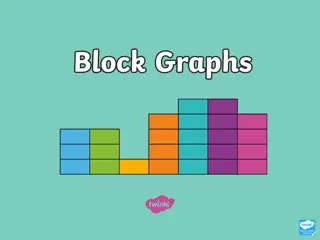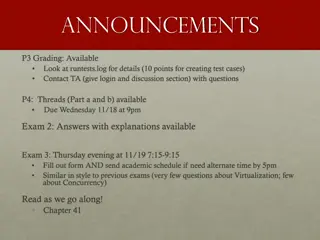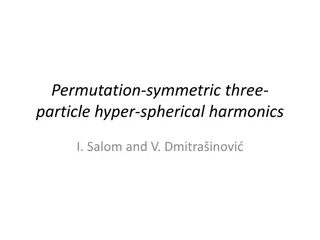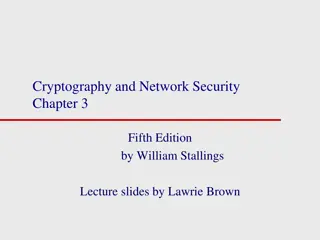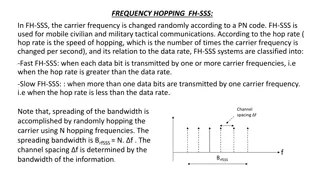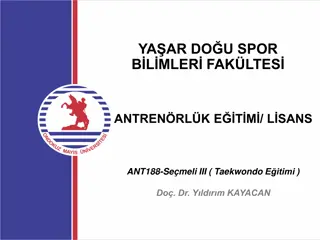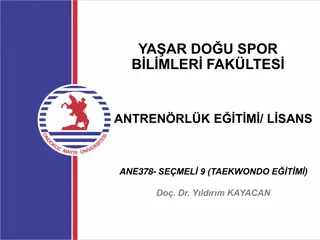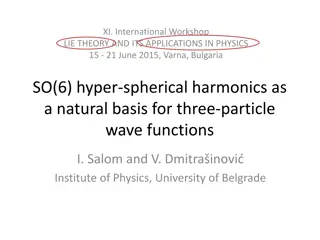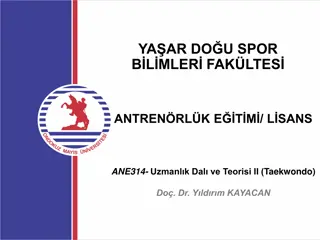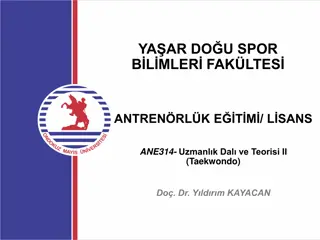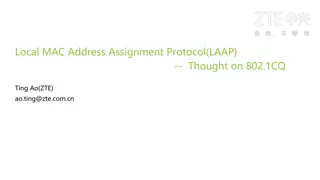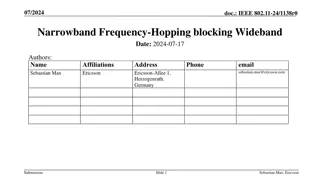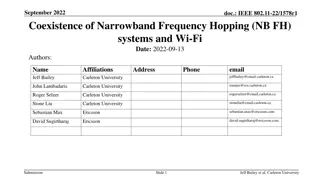Resolution of Round Hopping and Block Assignment in Hyper Blocks
Considerations for resolving issues related to round hopping and block assignment within hyper blocks for the IEEE P802.15 Working Group. The document discusses safeguards, interference mitigation techniques, coexistence improvements, backward compatibility, improved link budget, additional channels, enhanced ranging capabilities, reduced complexity/power consumption, hybrid operations, sensing capabilities, low-latency streaming, peer-to-peer communication, and infrastructure synchronization mechanisms.
Download Presentation

Please find below an Image/Link to download the presentation.
The content on the website is provided AS IS for your information and personal use only. It may not be sold, licensed, or shared on other websites without obtaining consent from the author. Download presentation by click this link. If you encounter any issues during the download, it is possible that the publisher has removed the file from their server.
E N D
Presentation Transcript
March 2023 Project: IEEE P802.15 Working Group for Wireless Personal Area Networks (WPANs) doc.: < 15-23-0129-00-04ab > Submission Title: Round hopping and block assignment in hyper blocks Date Submitted: March, 2023 Source: Rojan Chitrakar, Lei Huang, Kuan Wu, David Xun Yang (Huawei Technologies) Email: rojan.chitrakar@huawei.com Abstract: Considerations for round hopping and block assignment in hyper blocks Purpose: Resolve issues with round hopping and block assignment in hyper blocks. Notice: This document has been prepared to assist the IEEE P802.15. It is offered as a basis for discussion and is not binding on the contributing individual(s) or organization(s). The material in this document is subject to change in form and content after further study. The contributor(s) reserve(s) the right to add, amend or withdraw material contained herein. Release: The contributor acknowledges and accepts that this contribution becomes the property of IEEE and may be made publicly available by P802.15. Submission Slide 1 Rojan Chitrakar, et al
March 2023 doc.: < 15-23-0129-00-04ab > PAR Objective Proposed Solution (how addressed) Safeguards so that the high throughput data use cases will not cause significant disruption to low duty-cycle ranging use cases Interference mitigation techniques to support higher density and higher traffic use cases Other coexistence improvement Backward compatibility with enhanced ranging capable devices (ERDEVs) Improved link budget and/or reduced air-time Additional channels and operating frequencies Improvements to accuracy / precision / reliability and interoperability for high-integrity ranging Reduced complexity and power consumption Hybrid operation with narrowband signaling to assist UWB Enhanced native discovery and connection setup mechanisms Sensing capabilities to support presence detection and environment mapping Low-power low-latency streaming Higher data-rate streaming allowing at least 50 Mbit/s of throughput Support for peer-to-peer, peer-to-multi-peer, and station-to- infrastructure protocols Round hopping and block assignment issues in hyper block- based mode are resolved. Submission Infrastructure synchronization mechanisms Slide 2 Rojan Chitrakar, et al
March 2023 doc.: < 15-23-0129-00-04ab > Background: Hyper block Hyper block concept that supports NBA-MMS-UWB ranging is introduced in [1]. A hyper block is a group of blocks. Hyper block mode uses the time structure that is periodic Each hyper block consists of a whole number of blocks. different blocks may have different configuration for block duration, Round duration, and slot duration Hyper Block K+1 Hyper Block K Hyper Block K-1 Block 0 Block 1 Block 2 Block 0 Block 1 Block 2 Block 0 Block 1 Block 2 Hyper Block K Block 0 Block 2 Block 1 Round 5 Round 0 Round 0 Round 2 Round 0 Round 1 Round 1 RESPONSE RESPONSE RESPONSE RESPONSE RESPONSE RESPONSE RESPONSE RESPONSE POLL REPORT REPORT REPORT REPORT REPORT REPORT REPORT REPORT POLL POLL POLL POLL POLL POLL POLL [NB] : [UWB] : 1 1 1 1 4 4 1 1 4 4 1 1 2 2 2 2 1 1 3 3 3 3 6 6 1 1 4 4 1 1 2 2 5 5 3 3 1 1 4 4 2 2 3 3 One Ranging Round One Ranging Round One Ranging Round One Ranging Round One Ranging Round One Ranging Round [1] DCN 23-0059r0 (Jan 2023) Hyper block concept for use of NBA-MMS Submission Slide 3 Rojan Chitrakar, et al
March 2023 doc.: < 15-23-0129-00-04ab > Background: Round Hopping in 802.15.4z The controller may decide to hop to a different ranging round in the next ranging block (i.e., if participating ERDEVs are using ranging round j in ranging block N, they will use ranging round k in ranging block N + 1, where k != j). It is assumed that the devices participating in the ranging exchange have either (a) pre- negotiated a hopping sequence that is known to all devices, or (b) have exchanged all the information necessary such that each device can generate the hopping sequence so that they know which ranging round in each ranging block is to be used if hopping is triggered. The Hopping Mode field (in the RR IE) specifies the hop mode for the ranging block, where zero means no hopping and one means hopping. Submission Slide 4 Rojan Chitrakar, et al
March 2023 doc.: < 15-23-0129-00-04ab > Discussion Round hopping algorithm itself is not standardized in 802.15.4z but it assumes that such algorithm exist and all devices participating in ranging know which ranging round in each ranging block is to be used if hopping is triggered. It is also assumed that a round will be allocated for each device in each block. In addition the round hopping functions would assumed a fixed Number of Rounds per block. Submission Slide 5 Rojan Chitrakar, et al
March 2023 doc.: < 15-23-0129-00-04ab > Problem 1. One or more blocks (in a hyper block) may not be suitable for a device (e.g., due to insufficient slot or round duration, block assigned for a different application etc.), so controller may not allocate a round for a device in every block. => However a device may not be aware of this and still needs to check every block whether it is allocated a round in the block, leading to power wastage. 2. If the Hopping function assumes a fixed value for the Number of Rounds per block N_Round (e.g., 2) that is smaller than the maximum possible value (e.g., 6), only a subset of rounds may be selected in the blocks with more rounds (e.g., block 1). Hyper Block K-1 Hyper Block K Block 0 Block 0 Block 1 Block 2 Block 1 Block 2 Round 0 Round 1 Round 6 Round 0 Round 1 Round 2 Round 0 Round 1 Round 6 Round 0 Round 1 Round 2 ... ... Round 0 Round 1 Round 0 Round 1 Insufficient # of slots (or round duration) Allocated Round Legend: slots are never chosen Block assigned for a different application Submission Slide 6 Rojan Chitrakar, et al
March 2023 doc.: < 15-23-0129-00-04ab > Proposal In the first and each subsequent allocated rounds, the Initiator informs the next assigned block and the Number of Rounds in the assigned block. Note: The controller may dynamically assign any block in a hyper block to devices or a network based on factors, such as but not limited to: o Required slot numbers/durations, or application type (one-to-one, one-to-many ranging etc.), or transaction frequency requirements etc. Start time Hyper Block K-1 Hyper Block K Hyper Block K+1 Block n+2 (R.I. = 0) Block n+3 (R.I. = 1) Block n+4 (R.I. = 2) Block n-1 (R.I. = 0) Block n (R.I. = 1) Block n+1 (R.I. = 2) Block n+5 (R.I. = 0) Block n+6 (R.I. = 1) Block n+7 (R.I. = 2) Round 0 Round 1 Round 6 Round 0 Round 1 Round 2 Round 0 Round 1 Round 6 Round 0 Round 1 Round 2 Round 0 Round 1 Round 6 Round 0 Round 1 Round 2 ... ... ... Round 0 Round 1 Round 0 Round 1 Round 0 Round 1 Next Block, N_Rounds Next Block, N_Rounds Legend: Assigned Block Allocated Round Submission Slide 7 Rojan Chitrakar, et al
March 2023 doc.: < 15-23-0129-00-04ab > Proposal Once the next assigned block and the number of rounds in the block is known, devices (initiator(s) and responder(s)) can determine the allocated round in the next assigned block. If round hopping is not enabled, the allocated round is the same as in the previous block (unless a new round is explicitly assigned). If round hopping is enabled, the allocated round is calculated based on the block index and the Number of Rounds. A new IE, Enhanced Ranging Round IE (ERR IE) may be defined. The ERR IE may be included in any message sent by the Initiator to the Responder in the current round (for example in the RCM or in the measurement report). ERR IE Octets: 1 1 Bits: 0 1 - 15 Octets: 2 0 or 1 Hyper Block Index Relative Block Index Number of Rounds Hopping Mode Transmission Offset Round Index Index of the hyper block in which the next assigned block is located Relative Index of the next assigned block in the hyper block (first block = 0 etc.) Number of Rounds in the block indicated by the Relative Block Index Same meaning as in RR IE but applies to the next assigned block. Submission Slide 8 Rojan Chitrakar, et al
March 2023 doc.: < 15-23-0129-00-04ab > Summary We discussed the issue of block assignment and round hopping in hyper blocks. We proposed that in the first and each subsequent allocated rounds, the Initiator informs the next assigned block and the Number of Rounds in the assigned block. Submission Slide 9 Rojan Chitrakar, et al













